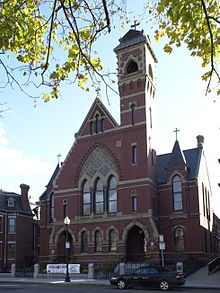Albanian Americans: Difference between revisions
rearrange infobox photos, but shouldn't they be shown in last name order? |
No edit summary |
||
| Line 42: | Line 42: | ||
<td>[[File:Donald Suxho Photo at game.jpg|100x100px]]</td> |
<td>[[File:Donald Suxho Photo at game.jpg|100x100px]]</td> |
||
<td>[[File:Emina Cunmulaj.jpg|100x100px]]</td> |
<td>[[File:Emina Cunmulaj.jpg|100x100px]]</td> |
||
<td>[[File:John Cena 134616.jpg|100x100px]]</td> |
|||
<tr> |
<tr> |
||
<tr> |
<tr> |
||
Revision as of 20:24, 10 November 2012
| ||||||||||||||||||||||||||||||||||
| Regions with significant populations | ||||||||||||||||||||||||||||||||||
|---|---|---|---|---|---|---|---|---|---|---|---|---|---|---|---|---|---|---|---|---|---|---|---|---|---|---|---|---|---|---|---|---|---|---|
| New York City Metropolitan Area[1], Northern New Jersey, Philadelphia Metropolitan Area, Boston Metropolitan Area, and other major American metropolitan areas | ||||||||||||||||||||||||||||||||||
| Languages | ||||||||||||||||||||||||||||||||||
| Albanian, American English | ||||||||||||||||||||||||||||||||||
| Religion | ||||||||||||||||||||||||||||||||||
| Roman Catholic, Albanian Orthodox, Muslim | ||||||||||||||||||||||||||||||||||
Albanian-Americans are United States citizens of full or partial Albanian ancestry. According to data from a 2008 Survey of the United States Government, there are 201,118 Americans of full or partial Albanian descent.[2]
Emigration History



The first documented Albanian to have emigrated to the United States was Kolë Kristofori (English: Nicholas Christopher), who landed in Boston in the early 1880s and is remembered as the pioneer of the Albanian ethnic group in the USA.[4] It wasn't until the 1900s (decade), however, that a large number of Albanians reached the US Eastern Coast: most of them were young bachelors from southern Albania.[4] However, the majority of this first wave of emigrants, approximatively 10,000, did not intend to permanently settle in the USA, and went back to Albania after World War I.[4] Right at this time, another group of emigrants from Albania reached the USA. This new group settled and intermarried in their new country.[4] The number of Albanians that reported the Albanian language as their mother tongue in 1920 was around 6,000.[4]
After World War II the Albanians who emigrated to the USA were mostly political emigrants and in 1970 the figure rose to around 17,000.[4]
Following the Expulsion of Cham Albanians from Greece in the aftermath of WWII, a large number of them migrated to the United States shortly after their expulsion from Greece, asserting that the Communist government in Albania discriminated and persecuted them[5] They managed to retain their traditions and language,[5] and created in 1973 the Chameria Human Rights Association which later merged and became Albanian American Organization Chameria which aimed to protect their rights.[6][7] (see Cham Albanians).
Allowing for the families that had abandoned their mother tongue, it is estimated that around 70,000 US citizens with an Albanian background lived in the USA in 1980.[8]
In the 1990s many Albanians from Albania, Montenegro, Serbia, the Republic of Macedonia, emigrated to the United States as refugees of war. Another Albanian American (Kosovar Albanian) community in the Riverside, California/San Bernardino area of California includes Kosovars who entered the United States at the March Joint Air Reserve Base in Riverside.[9]
Some Italian Americans who went to the U.S. during the early 20th century were descendants of 15th-century Albanian refugees to southern Italy and spoke an archaic dialect of Tosk Albanian called Arbëresh. The Greater New Orleans area has a large Arbëresh community, mostly descended from 19th-century Sicilian immigrants.[10]
Geographic Distribution
Currently the areas with the largest population of Americans with Albanian descent are New York City, Northern New Jersey, Philadelphia, Boston, Chicago, Detroit, and Hartford, Connecticut. The rapidly growing Albanian American population of Paterson, New Jersey, within the New York City Metropolitan Area, is the second largest outside of New York City itself.
List of Famous Albanian-Americans
References
- ^ "Yearbook of Immigration Statistics: 2011 Supplemental Table 2". U.S. Department of Homeland Security. Retrieved 2012-07-08.
- ^ a b US Census Bureau, Table: Ancestry for People with one or more Ancestry Categories Reported
- ^ "Yearbook of Immigration Statistics: 2011 Supplemental Table 2". U.S. Department of Homeland Security. Retrieved 2012-07-11.
- ^ a b c d e f Thernstrom, Stephan (1980). Harvard encyclopedia of American ethnic groups. p. 24. Retrieved 2010-06-23.
{{cite book}}: Cite has empty unknown parameter:|coauthors=(help) - ^ a b Vickers, Miranda. The Cham Issue - Where to Now? (PDF). Defence Academy of the United Kingdom.
- ^ Chameria Human Rights Association (2009). "Official site of the Chameria Human Rights Association" (in Albanian and English). Tirana, Albania. Retrieved 2009-03-31.
- ^ http://chameriaorganization.blogspot.com
- ^ Thernstrom, p.25
- ^ Fischer, Bernd J. "Albanian refugees seeking political asylum in the United States: process and problems" in Journal of Ethnic and Migration Studies 31.1 (2005)
- ^ Edwin E. Jacques, The Albanians: An Ethnic History from Prehistoric Times to the Present, 1995
















